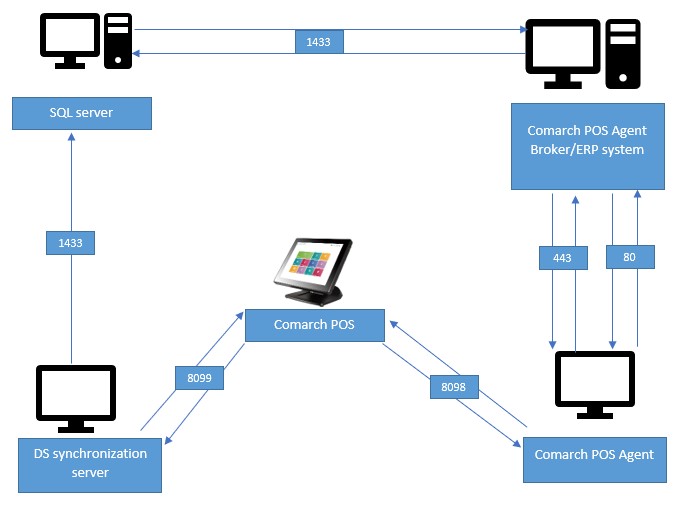Contents
Basic information
Comarch POS Agent (POS Agent) service provides the current information about stock levels on each point of sale during document registration. All the information is presented taking account of individual warehouses. All processes in a warehouse can be carried out with the Headquarters in the offline mode. Hence, using the service ensures full autonomy of the store by making sure that the stock level is always up-to-date.
When working offline with the Headquarters, a message broker Comarch POS Agent Broker is used to communicate with the POS Agent service. This component aggregates a message broker by sending the updated stock levels to the relevant POS Agent in a given store.
POS Agent service is a place where all information necessary for the point of sale will be stored, such as:
- parked documents
- statistics of entry/exit gate counter
- stock levels with reservations
How it works
The POS Agent service works as an independent service with own database on the same computer on which Comarch POS database is stored or a different one.
Prior to document configuration POS Agent verifies the correctness of stock levels in the following documents:
- trade documents:
- receipts (R) as well as their quantity and manual corrections
- sales invoices (SI) as well as their quantity and manual corrections
- sales order (SO)
- warehouse documents:
- warehouse movements (WM/WM+)
- internal receipts and releases (IR+/IR-) and their quantity corrections
- PO receipts and SO releases (POR/SOR) and their manual corrections
Installation and configuration
Comarch POS Agent is installed via the tool Comarch ERP Auto Update.
After running Comarch ERP Auto Update application, follow the steps below:
- On the Configuration tab, add the product Comarch Retail

- Add the component Comarch POS Agent to Comarch POS product

- Configure the Comarch POS Agent component. The configuration window is open by selecting the component and then the [Configuration] button. In the opened window, specify the data to connect to Microsoft SQL Server Management Studio server on which the POS Agent database will be installed.

Configuration of SQL server connection for POS Agent - Server Name – server name and instance on which a database will be installed
- Database Name – BOSDB_[profile_code] is suggested by default
- Login Credentials – login and password
Using the [Test Connection] button you can verify connection with the selected server.
- Finally, save the changes and close the component’s configuration window by selecting the buttons [Save] and [Close] respectively.
Configuration
- The POS Agent workstation needs to be configured in the ERP system. More information may be found in the ERP system help documentation in articles concerning the addition and configuration of a new POS workstation.
- In the next step, open the POS Agent installation directory and run the PosAgentConfigurator.exe application
- The application will display a message stating that the service is uninstalled
- After the button [OK] is selected, the application will start to load configuration parameters:

- Once the parameters are loaded, the configuration tool’s window will open:

- In the application, complete the following:
-
- POS Agent Service IP Address – IP address of the computer on which POS Agent has been installed
NoteThe Comarch POS Agent service requires a fixed IP of the computer on which it is installed.- POS Agent Service Port – the default port is 8098
- OMS Server Address – the default address is http://localhost:8099/DataService/
- POS Agent Code – POS Agent code provided in the ERP system; after successful registration, the field is deactivated
- POS Agent GUID – automatically assigned value
-
- To install the service, select the button [Install]

- You can verify the previously provided data with the button [Verify]. To register the POS Agent service, use the button [Register].
- To verify whether the process has completed successfully, go to the POS Agent tab in Comarch ERP Standard and check whether the values in the fields: Host, Port and GUID have been updated
In Comarch POS application, after the service is installed, you will see the icon: ![]() whose color informs about the service connection status:
whose color informs about the service connection status:
- Green – all services are running
- Yellow – one service is stopped
- Red – all services are stopped
Moreover, below the icon ![]() , there is also the [Service Settings] button that opens the service configuration window of Comarch POS application. The button is also available in the main menu under the [Configuration] tile.
, there is also the [Service Settings] button that opens the service configuration window of Comarch POS application. The button is also available in the main menu under the [Configuration] tile.

Comarch POS Agent service registration in command prompt
It is possible to register the Comarch POS Agent service in the Windows command prompt. Available commands include:
- –register
- –install
- –uninstall
- –setaddress –agentIP:127.0.0.1 –port:8098 (setting an IP address and port for the Comarch POS Agent service)
- –seterpaddress –adres:http://example.com (setting the OMS server address)
- –stop
- –start
- –help
- –status
- –waitforstatus
In order to register the Comarch POS Agent service in the Windows command prompt, it is necessary to complete the following steps:
1. Run the command prompt as administrator from the following location: C:\Users\user.name\AppData\Roaming\Microsoft\Windows\Start Menu\Programs\System Tools
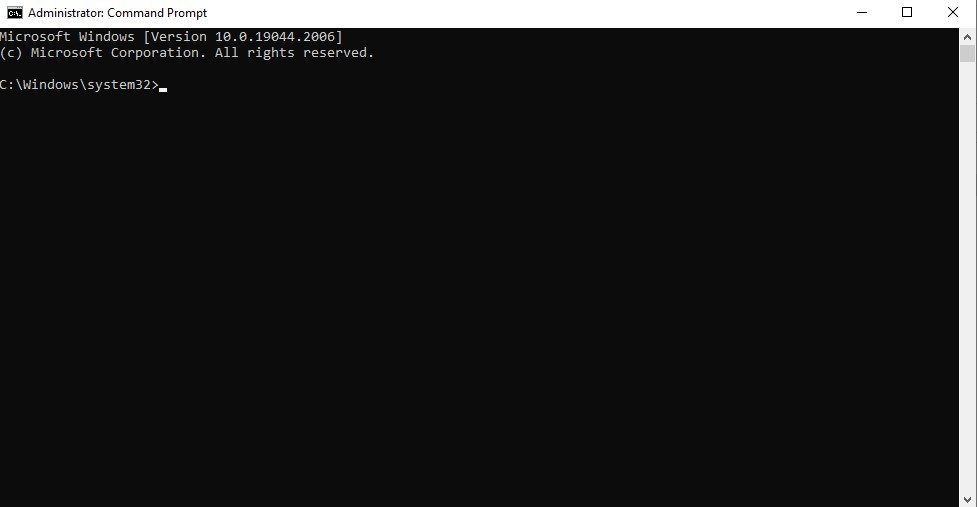
2. Find and copy the path to POS Agent Service Configuration Tool (in the folder containing Comarch POS Agent), for instance: C:\Program Files (x86)\Comarch Retail\Comarch Retail POS Agent
3. Enter cd C:\Program Files (x86)\Comarch Retail\Comarch Retail POS Agent in the command prompt and press [Enter]

4. Install the Comarch POS Agent service by entering POSAgentConfigurator.exe –install and pressing [Enter]
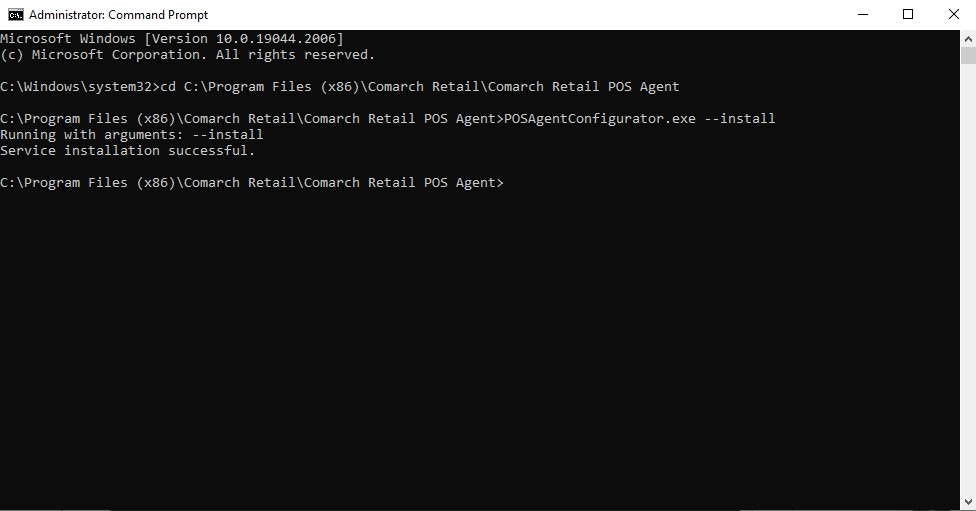
5. After successful installation, run the service by entering POSAgentConfigurator.exe –start and pressing [Enter]
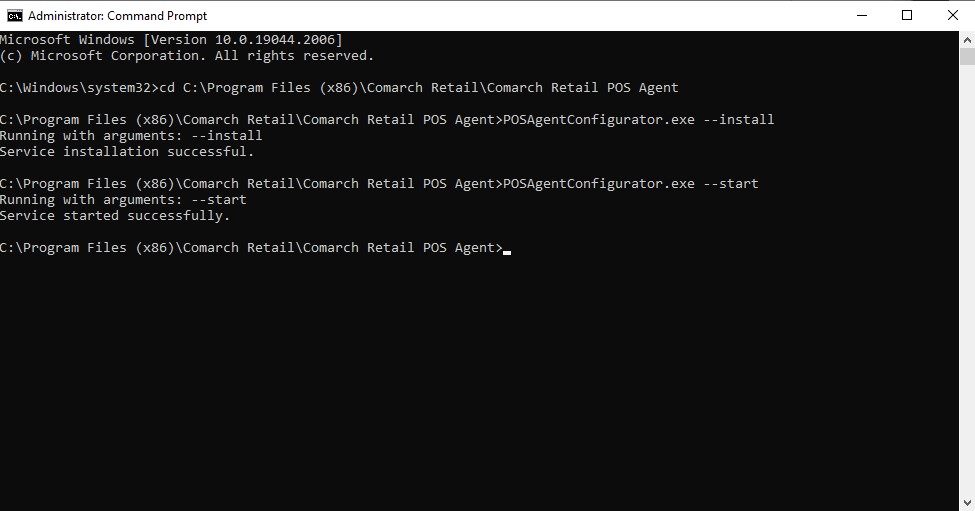
6. In order to register the service, enter POSAgentConfigurator.exe –register and press [Enter]
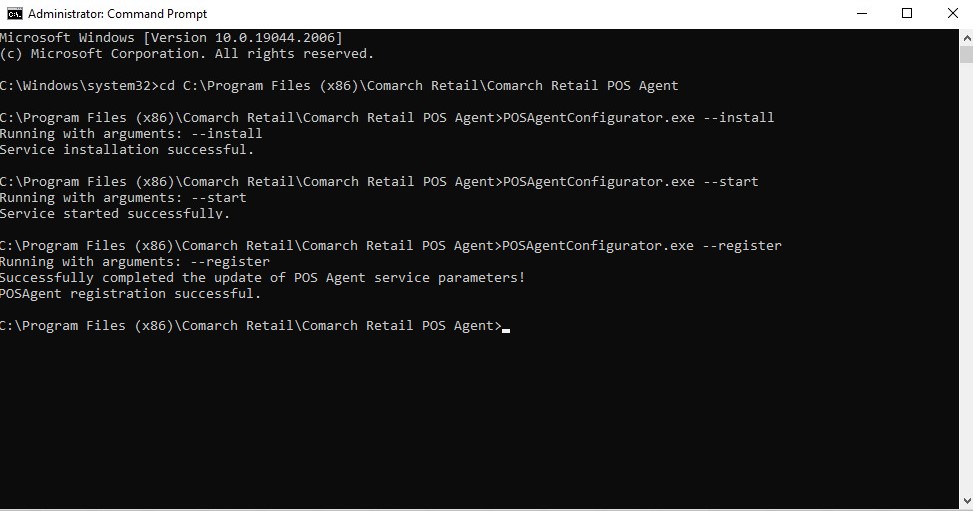
7. In order to verify the service’s connection status, enter POSAgentConfigurator.exe –status and press [Enter]
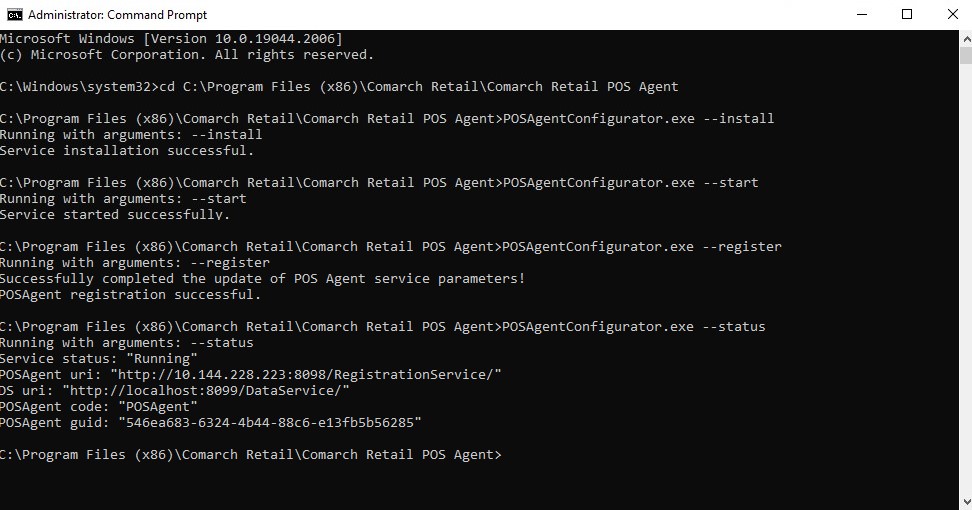
The status verification command displays information on:
-
- Service status
- Comarch POS Agent service address
- OMS service address
- Comarch POS Agent code
- GUID of Comarch POS Agent registered
Port requirements
The following diagram shows the communication of components by the default ports. The diagram also takes into account the direction of connection between components.
